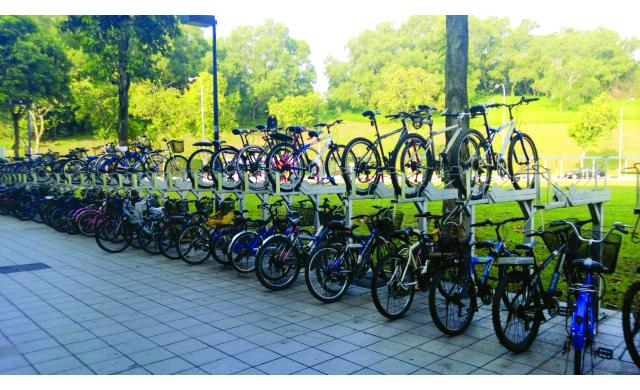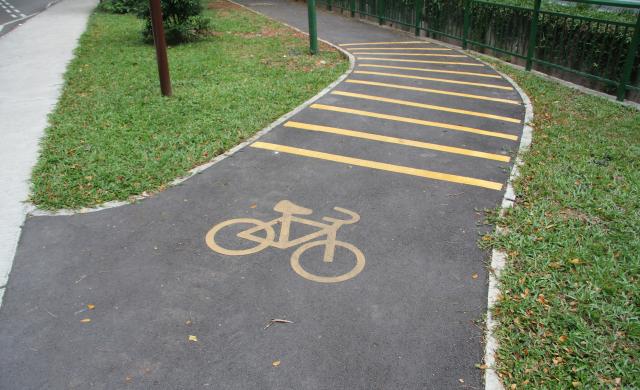Spin City
Why isn’t Singapore doing a better job of getting people on their bikes?
Let’s face it. Singapore isn’t known for trendsetting—we’re more we-like-it-if-you-like-it kind of folk. But we do pride ourselves on being green. And in shape. We don’t like falling behind in world rankings. And we certainly don’t have a problem throwing money and manpower at something if we think it’ll add to the country’s appeal. So the fact that cycling here is largely relegated to weekend warriors and hipster kids on their fixies is truly baffling. There’s no shortage of cyclists (the upcoming fifth edition of OCBC Cycle Singapore is expecting some 12,000 participants), but a real dearth of day-to-day cycling; the kind that makes you think, “You know what? I’m going to start biking to work, too!”
Over the past decade, cities like Copenhagen, Portland and even London (which not too long ago pretty much viewed bicycles as a public nuisance) have embraced urban cycling—and in particular cycling to work—as the kind of eco-friendly, health-promoting, good-news-all-round initiative worth promoting as much as possible. And, in so doing, those cities have been transformed. To visit them now is to accept cycling as part of the essential infrastructure of any great city—there are bikes everywhere and (seemingly) everybody bikes. Yet, here in Singapore, cycling remains resolutely a recreational activity. The city features on precisely none of the world’s best cycling cities lists, despite being far less congested than London, flatter than Amsterdam, smaller and easier to navigate than Paris, and with lower petty theft rates than pretty much anywhere on the planet. Most people here look at you in bafflement when you suggest cycling to work; yet they’ll happily chew your ear off complaining about MRT breakdowns, unavailable taxis and extortionate COE rates. Why is that? Inertia, laziness—or something more fundamental? And what can be done to turn all this around?
In our view, there’s an opportunity here for Singapore to lead the region in promoting a truly green transport solution and building a happier, healthier city; but it’ll require a concerted push, and a change in attitude from both the government and you, the people.

It’s true that there are some (sort of) encouraging signs. There’s already a fairly extensive network of cycling paths on the island; with more to come. By 2014, seven outlying towns will be equipped with 50km of intra-town cycling path networks that will connect riders to key public transport hubs like MRT stations and bus interchanges, amenities like markets and schools, as well as the existing Park Connector Network (the Ministry of National Development also promises that network will increase from 200km to 360km by 2020). The trouble is that, to make cycling to work viable, it needs to be visible. Which means it needs to be downtown, too—what popular local blogger and cycling advocate Mr. Brown describes as “a Park Connector Network that actually takes us somewhere we need to go.” Contrast that with London, where tourists can ride on dedicated bike lanes close to central landmarks like Oxford Street, Hyde Park and Leicester Square. So it’s encouraging to hear that the Land Transport Authority (LTA) is working with the Urban Redevelopment Authority (URA) and National Parks Board (NPB) to implement a network of cycling paths in Marina Bay, also expected to launch next year.
Further efforts have come from the LTA over the past year, with over 4,000 new cycle parking spaces added to 10 MRT stations like Admiralty, Chinese Garden, Simei and Yishun, with even more to come. The Housing Development Board (HDB) is also on the case. They’ve already installed a two-tiered cycle parking system at Singapore’s first eco-friendly HDB estate Treelodge@Punggol and are planning to do the same for Yuhua.

Bike paths and bike security are only part of the story, though. Two issues come up time and again when you ask people why they don’t cycle here: careless car drivers and the sticky, sweaty heat. But are we really willing to give up that easily? (Don’t answer that.) Until more people are seen biking to work, those in charge are unlikely to see that steps need to be taken to encourage even more to do it.
The weather itself isn’t going to change any time soon, global warming or not. And whereas cyclists in Amsterdam, New York and elsewhere regularly contend with rain and snow on their commute, on a good day they can at least go straight to their desks when they get into work. Here you’re pretty much guaranteed to need a shower by the time you arrive. Given how few office spaces here offer shower facilities, it’s surely that we should be lobbying for, rather than bemoaning our equatorial misfortune.
Infrastructure of a different sort is going to be crucial, too. Other cities that have successfully reinvented themselves as cycling centers have made bicycles themselves much more widely available—and affordable. Public bike sharing schemes have proven hugely popular elsewhere—Hangzhou (the world-leader) boasts more than 61,000 bicycles available from more than 2,000 stations, while Paris, often seen as the progenitor of the scheme in Europe (despite only launching in 2007 and with a similar scheme having been trialed in La Rochelle as early as the 1970s), has made some 20,000 two-wheelers available.
These bikes might not be (scratch that, never are) all that hot in the looks department, but the system works: there’s almost always a bike available nearby, you don’t have to be an expert to ride them, and the rental system is straightforward. In London, for example, you pay £2 for a day’s access to the scheme (or up to £90 for a year), then a fee depending on how long you’re actually out on the bike. The first half-hour is free, an hour is £1. Anyone over 14 years old can rent one of the bikes, fondly (and only sometimes disparagingly) referred to as Boris Bikes, after Boris Johnson, the mayor in charge when the scheme was launched. And the scheme has been so successful that, on a single day during the Olympics, close to 50,000 (!) rentals were made. (It’s sponsored by Barclays Bank. DBS, we’re just sayin’…) These schemes are also a boon for the tech-minded. Cities like Washington D.C have seen subcultures spring up to take advantage of all the data generated by bike sharing programs, to build smartphone apps, map efficient routes and identify gaps in the infrastructure. It’s the kind of big, civic-minded data project you’d figure/hope young Singaporeans would love to tackle.
But if it’s hard enough convincing Singaporeans who’ve been brought up to believe they need to own a car to show the world they’ve made it that a bicycle can also be a worthwhile investment (good luck adding a sixth C, for cycle, to the Five Cs), having them share a saddle with other users is yet another hurdle. Bike sharing, though, is only one way to go about it. Another success story out of the UK is the Cycle to Work Scheme, a government-assisted program whereby employers (who are encouraged to sign up in order to boost their CSR cred) can purchase bikes (and bike accessories) tax-free, and loan them to employees for a monthly fee so long as they’re riding at least part-way to work.
So, if there were some government will behind this, the models already exist for how to make it work. Rather more challenging is the change in mentality that would be required of other road users. (Though it’s worth saying that until you’ve been a cycling city as long as somewhere like Amsterdam, road safety remains a real problem, even for the likes of London.) Absent dedicated bike lanes, there’s no getting around the fact that cyclists are treated as second-class road users. Motorists in Singapore rarely practice basic road courtesy and safety when encountering cyclists (though accidents involving cyclists here did at least fall 17% from 2008 to 2011) and according to Mr. Brown and founder of amateur cycle racing club Joyriders Joyce Leong, this can be attributed to a lack of education. “The exposure to cycling from young is next to zero. Kids here are so precious; they’re used to being chauffeured around. When they grow up, they will have no idea what it’s like for cyclists and won’t know how to react to them,” Leong explains.
“People are clearly interested in bike-sharing facilities, but cyclist safety is a big concern,” says Francis Chu, co-founder of local group Lovecycling.net and director of Isuda Bike Share, which launched its pilot project at one-north last year. “We had many users sign up, but they gave up after a week or two because they didn’t feel safe sharing the roads with cars and trucks.”
“This scheme whereby cyclists share footpaths is pretty good, but it’s not promoting the safe usage of the roads, which is where cyclists should be, not on the footpaths harassing pedestrians,” says Alan Grant, a writer and editor who himself rides to meetings all over the city. “What we need are bike lanes on the roads and things like colored boxes at traffic lights and junctions that cars can’t enter. There should also be traffic lights allowing cyclists to move off seconds ahead of motorists.”
Both Grant and Chu agree that while the authorities are becoming more aware of the need to help, they’re not moving fast enough. Chu is still awaiting a response to the Lane Width proposal he submitted last year and in a parliamentary debate earlier this month, Secretary for Transport Muhammad Faishal Ibrahim continued to cite problems with, and not solutions for, on-road cycling. It seems the government is unlikely to change its stand, which Dr. Faishal put in stark terms in last September's debate: “In Singapore, land is a scarce commodity and, I dare say, road space is even scarcer… Most of our roads today are optimally sized for traffic conditions… Given our circumstances, we have therefore prioritized off-road cycling, which is safer and can cater to greater numbers of people… the Government is unable to accommodate all the wishes of all small communities, but must think of larger, overall needs.” (See the full response on the MoT website)

Chris Robb, MD of Spectrum Worldwide, who are the massive OCBC Cycle event organizers and recently carried out the Safe Cycling Campaign for the third year running, urges cooperation not confrontation. He points out that “Cycling has absolutely exploded in Singapore over the past five years.” But, he says, "we need to recognize that we’re in a tight space here in Singapore and work with what we have.”
Now, not 10 years from now, is when we should demand that this start to happen (it’s taken at least that long for it to take root in all the cities mentioned in this story). There are enough shoots to feel vaguely optimistic, but it’s still odd that there aren’t more and louder voices agitating for action. This really isn’t an issue that should get stalled by debate, disinterest or indecision. God forbid there be lengthy feasibility studies and limited roll-outs. (Mr. Brown again: “How long till we get there depends on the political will of our government. As it is, we're not very far off.”) Spend any time in cities like Portland or Paris and the question is not, “Why are they all cycling here?” but “Why the hell isn’t everywhere else?” Do we really want to be the last ones to the party?
Advertisement